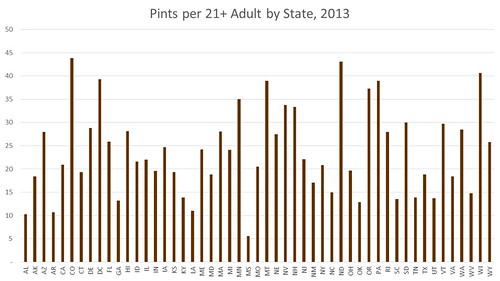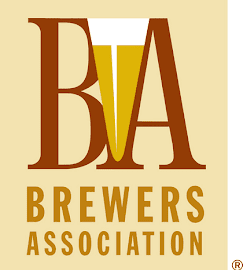
Bart Watson is the Chief Economist for the [U.S.] Brewers Association. In a recent post, he examined data concerning on-the-premises 'craft' beer draught sales and their correlation to 'craft' brewery success, especially that of smaller breweries.
- Most of the data reported in the beer media comes from off-premise[s].
- Off-premise[s] is more than 80 percent of overall beer volume.
- Data are easier to obtain [for off-the-premises], thanks to the magic of the barcode and sophisticated scanner systems.
- 35 percent of craft’s volume coming via on-premise[s] channels
- Brewpubs less than 1,000 barrels have production that is 95 percent draught
- Production brewers less than 1,000 barrels are on average 89 percent draught
- Median 'craft' brewery survyed] has 78 percent draught production.
- Size of the on-premise[s] beer market varies wildly by state, due to a variety of factors.
- Beer’s share of beverage alcohol
- Overall beer consumption levels
- Number of on-premise[s] outlets
- On-premise[s] culture
- Consumer preferences
- Socioeconomic factors.
- [Surprisingly not mentioned because ii is such an important factor: laws and regulations which permit or prohibit on-premises sales at breweries and brewpubs.]
- When you know both the size of the draught market in a state and the size of the total beer market, the size of the draught market is a much better predictor of the number of small and independent breweries.
- The on-premise[s] market has shifted over the past few years, with the continued spread of “rotation nation” and an increasingly fractured and competitive market for tap handles. This has likely created some challenges for regional craft brewers, the companies that are typically doing the heavy lifting in off-premise[s] channels. Given the greater dominance of chains in off-premise[s], those channels will likely never reach the diversity we are seeing in on-premise[s] markets.
The takeaway is, as Mr. Watson writes:
The data suggest that states where on-premise[s] is more important to the beer market, craft does better in the off-premise[s] [emphasis mine].
The logic is fairly simple: in places where more beer lovers are in bars and restaurants drinking beer and thus encountering craft, off-premise locations have better sales for craft brewers as well.
Beer author Jeff Alworth succinctly summarized all this at his blog, Beervana (doing his best beer reference of author Michael Pollan's food maxim):
Buy local, buy good, and buy on draft. [...] Drink on draft and you will create a virtuous cycle that buoys local breweries.
-----more-----
- Mr. Watson uses the spelling "draught" rather than "draft." I applaud that. However, he refers to 'on-premises' sales (that is, in restaurants, bars, and taprooms) as "on-premise" and to sales in stores and shops as "off-premise." The word "premise" refers to the basis of an argument, not to a location. The word "premises" (when not referring to multiple theses) refers to a building and the land on which it sits (and is always plural). The phrase "off-premise" (singular) literally refers back to an idea, in this case implying an 'off' (wacky, wrong) idea. The correct term for sales at a shop should be "off-the-premises" and for at a restaurant, "on-the-premises." I don't believe Mr. Watson's analysis to be wacky; thus, I have cavalierly taken the liberty of redacting his usage above.
- In his 2009 book, "In Defense of Food," Michael Pollan suggested a maxim for eating well: "Eat food. Not too much. Mostly plants."
- Read Mr. Watson's post in its entirety: On-Premise[s] Beer Data and Craft.
- Read Mr. Alworth's post in its entirety: A Draft Beer State of Mind.
- For more from YFGF:
- Follow on Twitter: @Cizauskas.
- Like on Facebook: YoursForGoodFermentables.
- Follow on Flickr: Cizauskas.
- Follow on Instagram: @tcizauskas.












No comments:
Post a Comment
Comment here ...